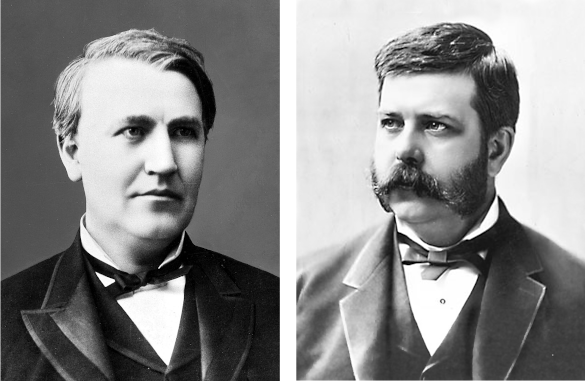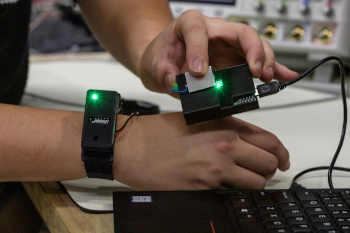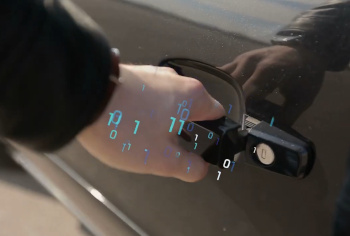Skin Communication
February 1, 2021
When I was in
elementary school, I read a
circuit construction article about a one
transistor "
lie detector" in a
hobby electronics magazine. This circuit measured
skin resistance, and the
theory of operation was that the
sweat of a
nervous person telling a
falsehood would decrease the skin resistance. I was fortunate in having a
neighbor who was an
electronics technician who had a part-time
television repair business, and he supplied the
components for this, and other, circuits. The functioning of that circuit wasn't that reliable, and the
utility of "lie detection" is quite
controversial.
The
direct current (DC) resistance of
human skin is generally very high, of the order of 10
k-ohm to many
megohms, depending on skin
dryness. I just used an
ohmmeter to measure the skin resistance between the tip of my
thumb and the tip of my
index finger (also known as the forefinger, pointer finger, and trigger finger) as 2.5 megohms. To establish
contact, I used an
electrode gel of the same type as used for electrodes for
electrocardiography.
The
electrical impedance of skin, the resistance seen when the excitation is
alternating current (AC) rather than direct current, is far different. Alternating current passes more easily through
cell membranes, so the resistance of skin (
R=V/I) is small when
frequency-excited. When current is allowed to pass through the skin, the overall body resistance from
head-to-
foot is just a few hundred ohms.[1]
The difference in effect of direct current (DC) and alternating current (AC) was brought to public attention in the early days of
electrification in the so-called
war of the currents, in which
Thomas Edison's (1847-1931) DC electric system was promoted as safer than the
George Westinghouse (1846-1914)/
Nikola Tesla AC system. Since
transformers could be used in the AC system, and not the DC system, AC power proved victorious in 1892 through the
merger of
Edison Electric with its AC rival to form
General Electric.

Thomas Edison and George Westinghouse around the time of the war of the currents. Edison was well known to the public, and there were even two biographical films about him in 1940, Young Tom Edison, staring Mickey Rooney (920-2014), and Edison, the Man, staring Spencer Tracy (1900-1967).[2-3] Westinghouse deserves to be better known. His invention of the railway air brake saved many lives. His early experiments in 1884 with a natural gas well at the backyard of his home in Pittsburgh, Pennsylvania, showed that this dangerous mine gas could be made useful.[4] (Photograph of Thomas Edison, c. 1882, left. and photograph of George Westinghouse, 1884, right, both from Wikimedia Commons.)
Skin
conductivity means that you can exchange
data with a
handshake, or by a
finger touch. Why would this be important, since
Bluetooth is the usual method for short-range data
communication? The reason is an
analogy to the difference between using an actual
credit card at a
point-of-sale terminal and using your credit card for an
online transaction. The physical card is always more secure.

Credit card numbers have an included check digit that detects any single-digit error and nearly all transpositions of adjacent digits.
The check digit is computed using the Luhn algorithm, patented in 1960 by IBM computer scientist, Hans Peter Luhn.[5] The algorithm is a simple check for mistyped information.
The patent has long since expired, so the method is in common use for many number cards.
(Wikimedia Commons image by Photographer Lotus Head.)
The idea of the human body as a conduit to transfer data from a
worn device containing things such as
passwords has been a topic of
research by
Shreyas Sen, an
associate professor of
electrical and computer engineering and his research team at
Purdue University (West Lafayette, Indiana). They've
published their research results in a series of recent
papers.[6-11]
Their method, which they've named BodyWire-HCI, doesn't use
radio frequencies. Instead, it's a
baseband transmission in which an
electric field is
modulated by a
data stream at
frequencies below 1
MHz.[6,8] Data will only pass through the conductive communication path of the human body.[6] While radio frequency
signals from Bluetooth can be detected at 30
feet, signals from the BodyWire-HCI approach require physical touch.[7-9]

A prototype wristband device is used for touch communication with a laptop computer.
The device appears bulky in this image, but it can be shrunk to a more aesthetic size.
(Purdue University photo by John Underwood.)
The human-side
transceiver for this touch
signalling could be a
wristband device that makes contact with the skin (see photo).[7] Applications include opening
doors presently opened with a
card reader, and
payment terminals.[7] A
local area network could even be implemented within the body so
implanted medical devices such as
pacemakers and
insulin pumps can communicate with a
handheld smartphone.[7] As Sen says, a
pocket-based device is also
feasible,
"You wouldn’t have to bring a device out of your pocket. You could leave it in your pocket or on your body and just touch."[7]
This work was
funded by the
National Science Foundation and the
Air Force Office of Scientific Research.[7,9] As could be expected, the Purdue research group has applied for patents on this technology.[7]

Keyless entry.
Skin data communication with a car door handle would allow access without transmission of radio frequency signals exposed to hackers.
(Screenshot of a Purdue Engineering YouTube Video.[11])
References:
- Raymond M. Fish and Leslie A. Geddes, "Conduction of Electrical Current to and Through the Human Body: A Review," Eplasty, vol. 9: no. 44 (October 12, 2009). This is an open access paper with a PDF file here.
- Young Tom Edison (1940), Norman Taurog, Director, on the Internet Movie Database.
- Edison, the Man (1940), Clarence Brown, Director, on the Internet Movie Database.
- Pioneering Natural Gas Innovations at the Westinghouse Memorial Website.
- H.P. Luhn, "Computer for verifying numbers," U.S. Patent No. 2,950,048, August 23, 1960 (via Google Patents).
- Shovan Maity, David Yang, Scott Stanton Redford, Debayan Das, Baibhab Chatterjee, and Shreyas Sen, "BodyWire-HCI: Enabling New Interaction Modalities by Communicating Strictly During Touch Using Electro-Quasistatic Human Body Communication," ACM Transactions on Computer-Human Interaction, vol. 27, no. 6 (November, 2020), Article no. 39, https://doi.org/10.1145/3406238.
- Kayla Wiles, "Tech makes it possible to digitally communicate through human touch," Purdue University Press Release, December 3, 2020.
- Debayan Das, Shovan Maity, Baibhab Chatterjee, and Shreyas Sen, "Enabling covert body-area network using electro-quasistatic human body communication," Scientific Reports, vol. 9, Article no. 4160 (March 11, 2019), doi: 10.1038/s41598-018-38303-x. This is an open access paper with a PDF file here.
- Kayla Wiles, "Your body is your internet – and now it can't be hacked," Purdue University Press Release, March 12, 2019.
- Shreyas Sen, Shovan Maity and Debayan Das, "Turning the Body Into a Wire," IEEE Spectrum, November 24, 2020.
- Digital Communication through Human Touch, YouTube Video by Purdue Engineering, December 3, 2020.
Linked Keywords: Elementary school; circuit design; circuit construction; scientific literature; article; transistor; polygraph; lie detector; Popular Electronics; hobby electronics magazine; electrodermal activity; skin resistance; theory; sweat gland; sweat; emotion; nervous; deception; falsehood; neighborhood; neighbor; electronics technician; television set; workshop; repair business; electronic component; utility of "lie detection"; controversy; controversial; direct current (DC); human skin; ohm; k-ohm; megohm; dryness; ohmmeter; thumb; index finger; contact resistance; electrode; gel; electrocardiography; electrical impedance; alternating current (AC); cell membrane; Ohm's law; R=V/I; frequency; head; foot; electrification; war of the currents; Thomas Edison's (1847-1931); George Westinghouse (1846-1914); Nikola Tesla; transformer; merger; Edison Electric; General Electric; celebrity; biography; biographical; film; Young Tom Edison; Mickey Rooney (920-2014); Edison, the Man; Spencer Tracy (1900-1967); invention; railway air brake; experiment; natural gas; natural gas well; backyard; home; Pittsburgh, Pennsylvania; hazard; dangerous; firedamp; mine gas; Wikimedia Commons; electrical conductivity; data; handshake; finger; touch; Bluetooth; communication; analogy; credit card; point-of-sale terminal; Internet; online; number; check digit; error; transposition; numerical digit; computation; computed; Luhn algorithm; patent; patented; IBM; computer scientist; algorithm; Photographer Lotus Head; apparel; worn; password; research; Shreyas Sen; associate professor; electrical and computer engineering; Purdue University (West Lafayette, Indiana); paper; radio frequencies; baseband transmission; electric field; modulation; modulated; data stream; MHz; signals; foot (unit); prototype; wristband; touch; laptop computer; aesthetics; aesthetic; John Underwood; transceiver; signal (electrical engineering); signalling; door; card reader; payment terminal; local area network; implant (medicine); implanted; medical device; artificial cardiac pacemaker; insulin pump; mobile device; handheld; smartphone; pocket; feasible; funding of science; funded; National Science Foundation; Air Force Research Laboratory; Air Force Office of Scientific Research; remote keyless system; Keyless entry; data communication; automobile; car; door handle; transmission (telecommunication); hacker (computer security).